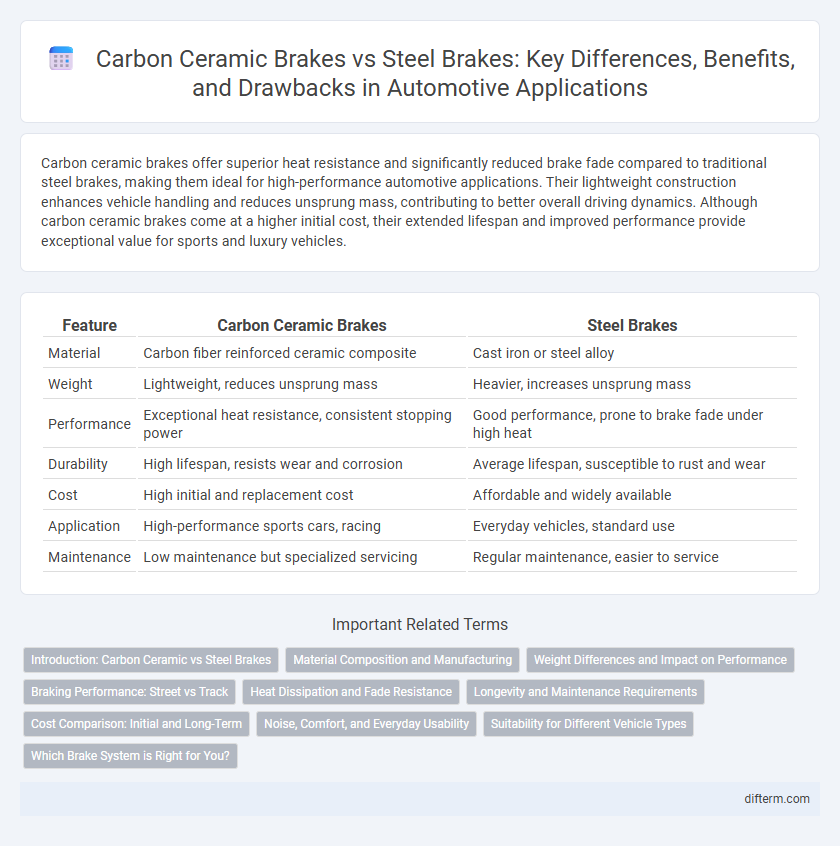Carbon ceramic brakes offer superior heat resistance and significantly reduced brake fade compared to traditional steel brakes, making them ideal for high-performance automotive applications. Their lightweight construction enhances vehicle handling and reduces unsprung mass, contributing to better overall driving dynamics. Although carbon ceramic brakes come at a higher initial cost, their extended lifespan and improved performance provide exceptional value for sports and luxury vehicles.
Table of Comparison
| Feature | Carbon Ceramic Brakes | Steel Brakes |
|---|---|---|
| Material | Carbon fiber reinforced ceramic composite | Cast iron or steel alloy |
| Weight | Lightweight, reduces unsprung mass | Heavier, increases unsprung mass |
| Performance | Exceptional heat resistance, consistent stopping power | Good performance, prone to brake fade under high heat |
| Durability | High lifespan, resists wear and corrosion | Average lifespan, susceptible to rust and wear |
| Cost | High initial and replacement cost | Affordable and widely available |
| Application | High-performance sports cars, racing | Everyday vehicles, standard use |
| Maintenance | Low maintenance but specialized servicing | Regular maintenance, easier to service |
Introduction: Carbon Ceramic vs Steel Brakes
Carbon ceramic brakes offer superior heat resistance and reduced weight compared to traditional steel brakes, enhancing braking performance and vehicle efficiency. These brakes provide longer lifespan and improved fade resistance under extreme driving conditions, making them ideal for high-performance and luxury vehicles. Steel brakes, while more affordable and widely used, tend to wear faster and are prone to overheating during intense use.
Material Composition and Manufacturing
Carbon ceramic brakes consist of carbon fibers embedded in a ceramic matrix, offering superior heat resistance and lightweight properties compared to traditional steel brakes made from cast iron or steel alloys. The manufacturing process of carbon ceramic brakes involves high-temperature sintering and complex layering techniques to achieve exceptional durability and thermal performance. In contrast, steel brakes are produced through casting and machining, making them more cost-effective but prone to higher wear and heat-induced fade in demanding driving conditions.
Weight Differences and Impact on Performance
Carbon ceramic brakes weigh significantly less than steel brakes, reducing unsprung mass and improving vehicle handling and acceleration. The lower weight of carbon ceramic brakes enhances responsiveness and stability, particularly in high-performance and racing applications. This weight advantage also contributes to better fuel efficiency and reduced brake fade under extreme conditions.
Braking Performance: Street vs Track
Carbon ceramic brakes offer superior heat dissipation and consistent braking performance under extreme conditions, making them ideal for high-performance track driving. Steel brakes provide reliable stopping power and quicker warm-up times, better suited for everyday street use where temperature extremes are less frequent. On the track, carbon ceramic brakes maintain fade resistance and performance across multiple laps, while steel brakes may experience brake fade and reduced efficiency under prolonged stress.
Heat Dissipation and Fade Resistance
Carbon ceramic brakes exhibit superior heat dissipation compared to steel brakes, maintaining lower temperatures under extreme braking conditions. Their enhanced fade resistance stems from the material's ability to withstand high thermal stress without glazing or loss of friction. This results in consistent braking performance and prolonged component lifespan in high-performance automotive applications.
Longevity and Maintenance Requirements
Carbon ceramic brakes offer significantly longer lifespan compared to steel brakes, often lasting over 100,000 miles under typical driving conditions. Their resistance to heat and wear reduces the frequency of replacements and maintenance, making them ideal for high-performance and endurance applications. Steel brakes require more frequent servicing due to faster wear rates and susceptibility to corrosion, leading to higher long-term maintenance costs.
Cost Comparison: Initial and Long-Term
Carbon ceramic brakes have a significantly higher initial cost compared to steel brakes, often costing two to three times more due to advanced materials and manufacturing processes. However, their longer lifespan and superior heat resistance lead to lower long-term replacement and maintenance expenses. Steel brakes offer a more affordable upfront investment but incur frequent replacement costs and performance degradation under extreme conditions.
Noise, Comfort, and Everyday Usability
Carbon ceramic brakes offer significantly reduced noise levels compared to steel brakes due to their advanced friction material and design, making them ideal for quiet, comfortable rides. They provide superior thermal stability, minimizing brake fade and ensuring consistent performance, which enhances everyday usability in both city driving and high-performance conditions. Despite higher initial costs, carbon ceramic brakes excel in comfort and durability, with less dust and wear, offering long-term benefits for automotive enthusiasts and daily drivers alike.
Suitability for Different Vehicle Types
Carbon ceramic brakes offer superior heat resistance and reduced weight, making them ideal for high-performance sports cars and racing vehicles that demand enhanced braking under extreme conditions. Steel brakes, known for their durability and cost-effectiveness, are well-suited for everyday passenger cars and heavy-duty trucks, providing reliable performance in varied driving environments. The choice between carbon ceramic and steel brakes depends largely on the vehicle's intended use, balancing performance needs with budget considerations.
Which Brake System is Right for You?
Carbon ceramic brakes offer superior heat resistance, reduced weight, and longer lifespan compared to steel brakes, making them ideal for high-performance and luxury vehicles. Steel brakes provide reliable stopping power at a lower cost and are easier to maintain, suitable for daily driving and budget-conscious owners. Choosing between carbon ceramic and steel brakes depends on driving style, vehicle type, and budget considerations.
carbon ceramic brakes vs steel brakes Infographic

 difterm.com
difterm.com